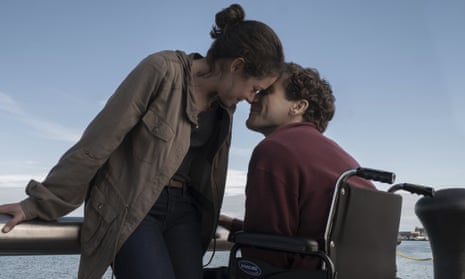‘Nothing about us, without us!” – a powerful statement of engagement, created during the disability riots that led to the creation of the Disability Discrimination Act in the UK in 1995, but does it still have relevance today? I have worked as a disabled actor, writer and producer for the last 10 years and I would argue that the phrase “nothing about us, without us” has never been more important.
During the last two weeks, the London film festival, which closes this evening, has prominently included some very interesting films featuring disability. Two films gaining much attention are Stronger, starring Jake Gyllenhaal as Jeff Bauman, who became a double amputee after the Boston marathon bombings in 2013, and Breathe, with Andrew Garfield as Robin Cavendish who became paralysed by polio from the neck down in 1958 and, against all odds, became a disability advocate.
At face value, a disabled person might look at these films and question the use of a non-disabled actor in the lead roles, but both films hold the key to the entire disability argument.
Stronger and Breathe are based on true stories, not some fictional narrative far removed from the reality of disability, and both films actively engaged the person and families involved. Jeff Bauman was consulted on Stronger, while Jonathan Cavendish (son of Robin Cavendish) is one of the producers on Breathe.
But why is disability representation important at all?
There are 13 million disabled people living in the UK, roughly 20% of the population. The annual disposable income of all households with at least one member of the family with a disability is £249bn, a staggering amount which is referred to as the purple pound. Yet this large minority, with a large amount of money to spend, is not being targeted by the media as a valued audience.
Then there is also the social value of disability representation. Put simply, the disabled community is not being allowed the right to comment on the world around it. Imagine the frustration in America if no one could comment on President Trump?
It is the duty of the arts to highlight and change perceptions. The problem comes when non-disabled people are the only people creating the narrative. While they might be able to understand some of the medical aspects, to represent us they must understand our culture and that is where most depictions of disability fail.
A non-disabled writer with no experience of disability will have no clue about the smell of burning rubber in a sports hall during a wheelchair basketball match, what it’s like to sit at home with your father cleaning your wheelchair, learning which spanner to use on it, or that loving moment when you kiss your wife at the altar and she sits on your lap.
Those moments come from my experience: that combined experience shared with other disabled people creates our culture and who we are as a community. It is vitally important that no film in the future depicts disability without engaging disabled people.
At the film festival, there were two brilliant examples of how simple engagement leads to a more authentic portrayal.
Wonderstruck, directed by Todd Haynes, features a 14-year-old deaf actress, Millicent Simmonds. This not only helps produce a more authentic portrayal, Todd has contributed to the building of a disabled artist’s career.
In The Art of Disability, I note the importance of the smaller roles in a film. I call it my “rule of three” – for every one part you take away from a disabled artist, give back three. If you need an “A-list” non-disabled actor in the lead role to get the film financed, that’s fine – give three lesser roles to disabled artists. A “diversity offset”, it would stimulate demand in the industry for disabled artists and the rest of the industry would then react to this demand and before long we would be seeing disabled artists in leading roles.
David Proud is an actor and the author of The Art of Disability
